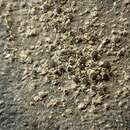en
names in breadcrumbs


Rinodina is a genus of lichen-forming fungi in the family Physciaceae. The genus has a widespread distribution and contains about 265 species.[2] It is hypothesized that a few saxicolous species common to dry regions of western North America, southern Europe, North Africa and central Asia may date back 240 million years to the Middle Triassic.[3]
Rinodina is a genus of lichen-forming fungi in the family Physciaceae. The genus has a widespread distribution and contains about 265 species. It is hypothesized that a few saxicolous species common to dry regions of western North America, southern Europe, North Africa and central Asia may date back 240 million years to the Middle Triassic.
Piprasamblik (Rinodina (Ach.) Gray) on samblike perekond rosettsamblikuliste sugukonnast.
Eestis kasvab 16 liiki piprasamblikke:
Piprasamblik (Rinodina (Ach.) Gray) on samblike perekond rosettsamblikuliste sugukonnast.
Rinodina (Ach.) Gray (bruniec) – rodzaj grzybów z rodziny obrostowatych (Physciaceae)[1]. Ze względu na współżycie z glonami zaliczany jest do grupy porostów[2].
Pozycja w klasyfikacji według Index Fungorum: Physciaceae, Teloschistales, Lecanoromycetidae, Lecanoromycetes, Pezizomycotina, Ascomycota, Fungi[1].
Synonimy nazwy naukowej: Berengeria Trevis., Courtoisia L. Marchand, Dictyorinis Clem., Lecanora subdiv. Rinodina Ach., Malmia M. Choisy, Merorinis Clem., Mischoblastia A. Massal., Mischolecia M. Choisy, Pachysporaria (Malme) M. Choisy, Placothallia Trevis., Pleorinis Clem., Pseudobuellia B. de Lesd., Rhinodinomyces E.A. Thomas ex Cif. & Tomas., Rinodina subsect. Pachysporaria Malme[3].
Nazwa polska według W. Fałtynowicza[2].
Nazwy naukowe na podstawie Index Fungorum[5]. Nazwy polskie według W. Fałtynowicza[2].
Rinodina (Ach.) Gray (bruniec) – rodzaj grzybów z rodziny obrostowatych (Physciaceae). Ze względu na współżycie z glonami zaliczany jest do grupy porostów.